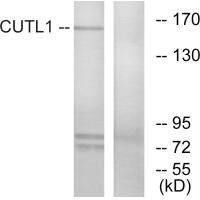CUX1 Antibody
-
中文名称:CUX1兔多克隆抗体
-
货号:CSB-PA273037
-
规格:¥2024
-
图片:
-
其他:
产品详情
-
产品名称:Rabbit anti-Homo sapiens (Human) CUX1 Polyclonal antibody
-
Uniprot No.:P39880
-
基因名:CUX1
-
宿主:Rabbit
-
反应种属:Human,Mouse
-
免疫原:Synthesized peptide derived from N-terminal of Human CUTL1.
-
免疫原种属:Homo sapiens (Human)
-
克隆类型:Polyclonal
-
纯化方式:The antibody was affinity-purified from rabbit antiserum by affinity-chromatography using epitope-specific immunogen.
-
浓度:It differs from different batches. Please contact us to confirm it.
-
产品提供形式:Liquid
-
应用范围:ELISA,WB
-
推荐稀释比:
Application Recommended Dilution WB 1:500-1:3000 -
Protocols:
-
储存条件:Upon receipt, store at -20°C or -80°C. Avoid repeated freeze.
-
货期:Basically, we can dispatch the products out in 1-3 working days after receiving your orders. Delivery time maybe differs from different purchasing way or location, please kindly consult your local distributors for specific delivery time.
相关产品
靶点详情
-
功能:Transcription factor involved in the control of neuronal differentiation in the brain. Regulates dendrite development and branching, and dendritic spine formation in cortical layers II-III. Also involved in the control of synaptogenesis. In addition, it has probably a broad role in mammalian development as a repressor of developmentally regulated gene expression. May act by preventing binding of positively-activing CCAAT factors to promoters. Component of nf-munr repressor; binds to the matrix attachment regions (MARs) (5' and 3') of the immunoglobulin heavy chain enhancer. Represses T-cell receptor (TCR) beta enhancer function by binding to MARbeta, an ATC-rich DNA sequence located upstream of the TCR beta enhancer. Binds to the TH enhancer; may require the basic helix-loop-helix protein TCF4 as a coactivator.; Plays a role in cell cycle progression, in particular at the G1/S transition. As cells progress into S phase, a fraction of CUX1 molecules is proteolytically processed into N-terminally truncated proteins of 110 kDa. While CUX1 only transiently binds to DNA and carries the CCAAT-displacement activity, CDP/Cux p110 makes a stable interaction with DNA and stimulates expression of genes such as POLA1.
-
基因功能参考文献:
- Our data indicate that there exist frameshift mutations of CUX1 and SIRT1 genes as well as intratumoral heterogeneity of CUX1 frameshift mutation in high microsatellite instability cancers, which together might play a role in tumorigenesis of gastric cancer and colorectal cancer with high microsatellite instability PMID: 29363918
- CUX1 is enriched at sites of DNA looping, as determined by Hi-C analysis, and these loops connect CUX1 to the promoters of regulated genes. PMID: 28369554
- our results have uncovered the requirement for CUX1 expression in cancer cells with elevated reactive oxygen species levels PMID: 28147323
- Study found are higher CUTL1 expression level in non-small cell lung cancer (NSCLC) tissues and showed that CUTL1 induced epithelial-mesenchymal transition in NSCLC. PMID: 28405678
- Results show that Cux1 is expressed in cerebellar granule cell precursors and downregulated as they terminally differentiate; coexpression analysis in human medulloblastomas suggests another function related to DNA integrity and stability PMID: 25096634
- High CUX1 expression is associated with metastasis in pancreatic neuroendocrine neoplasms. PMID: 25248790
- s identified CUX1 as an important modulator of the TAMs phenotype and function by modulating NF-kappaB-dependent cytokines. PMID: 24336331
- This is a novel gene implicated in atrial fibrillation PMID: 25124494
- CASP is specifically cleaved by granzymeB. PMID: 25159843
- Suggest that CUTL1 may regulate the proliferation of malignant melanoma by modulating the expression of cell cycle-related proteins. PMID: 24686420
- CUX1 expression is associated with tumour progression and tumor burden. [Review] PMID: 25190083
- Loss of CUX1 is associated with myeloid neoplasms. PMID: 24429498
- Cux1 is a tumor suppressor and inactivating CUX1 mutations promote tumorigenesis. PMID: 24316979
- Our results provide the first evidence that polymorphisms of the CUX1 gene may be associated with response to antidepressant treatment in Japanese patients with MDD. PMID: 22584459
- p110 CUX1 can mediate transcriptional repression or activation of specific genes when bound at variable distances from the transcription start site. PMID: 23590133
- s found that both chromosomal inversions target the cut-like homeobox 1 (CUX1) gene on chromosomal band 7q22.1 in a way which is functionally equivalent to the more frequently observed del(7q) cases. PMID: 22965931
- Cutl1 played transcriptional level mediated by signal transduction, translational level mediated by miR122, posttranslational level such as phosphorylation, de-phosphorylation, acetylation and proteolytic cleavage. PMID: 23085261
- overexpression of active CUTL1 significantly resulted in increased cancer tissue response to chemotherapy and therefore inhibited growth, whereas knockdown of CUTL1 conferred resistance to chemotherapy. PMID: 23255599
- Data indicate CUX1 as a conserved, haploinsufficient tumor suppressor frequently deleted in myeloid neoplasms. PMID: 23212519
- The data demonstrates that the autism spectrum disorder-associated A-C intronic haplotype of the ENGRAILED2 gene is a transcriptional activator, and both CUX1 and NFIB mediate this activity. PMID: 22180456
- we find repression of apoptosis regulators by Cux1 in human cancer cells. PMID: 22438831
- cux1 is associated with cell functions and human disease. PMID: 22306263
- modifications of CUX1 expression lead to aberrant expression of type I collagen, which may provide a molecular basis for fibrogenesis PMID: 21471005
- we identified a novel CUX1-FGFR1 fusion oncogene in a patient with the 8p11 myeloproliferative syndrome and demonstrated its transforming potential in the Ba/F3 cell line. PMID: 21330321
- screening for mutations in CUX1 using 15 secondary acute myeloid leukemia cases with preceding myeloproliferative neoplasms or loss-of-heterozygosity on chromosome 7q (collaborative study in several countries) PMID: 21674579
- Transcriptional targets of CUX1 involved in DNA replication and bipolar mitosis defined a gene expression signature that, across 12 breast cancer gene expression datasets, was associated with poor clinical outcome. PMID: 21245318
- Elevated levels of cux1 are associated with inflammatory bowel disease. PMID: 20848487
- GRIA3 plays a role as a mediator of tumor progression in pancreatic cancer downstream CUX1. PMID: 20689760
- data indicate that CUX1 represents an important survival factor downstream of PI3K/Akt, which orchestrates a transcriptional programme mediating resistance to apoptosis in pancreatic cancer. PMID: 20442202
- findings show that CUTL1 expression is gradually silenced at the posttranscriptional level during liver development; overexpression and knockdown studies that miR-122 repressed CUTL1 protein expression in HCC cell lines PMID: 20842632
- Transfection of keratinocytes with plasmid DNA leads to the loss of detectable DNA-binding activity of CCAAT displacement protein. PMID: 11953010
- Analysis of flanking sequences of IgH and Ig kappa V region genes show extensive heterogeneity in frequency and location of CDP binding sites and capability of CDP to bind to the nuclear matrix. PMID: 12193717
- Data report the characterization of a mammalian coiled-coil protein, CASP, a Golgi protein that shares with giantin a conserved histidine in its transmembrane domain. PMID: 12429822
- Lack of LF expression in the acute promyelocytic leukemia cell line NB4 is associated with the persistent binding of the silencer CCAAT displacement protein (CDP/cut) to the LF promoter in these cells. PMID: 12522000
- correlation between binding of CDP/Cux to the DNA pol alpha promoter and the stimulation of gene expression PMID: 12665598
- CDP, in conjunction with one or more viral proteins, binds to the packaging sequences of Adenovirus type 5 to initiate the encapsidation process PMID: 12743282
- our data suggested that somatic mutations in CDP gene were rare in unselected uterine leiomyomas PMID: 12766905
- interaction of G9a with a sequence-specific transcription factor that regulates gene repression through CDP/cut. PMID: 15269344
- CUTL1 plays a central role in coordinating a gene expression program associated with cell motility and tumor progression. PMID: 15950902
- Binding of E2 at the binding sites play an important role in overcoming inhibition of E1 complex formation caused by the binding of CDP to the origin of replication. PMID: 16529788
- PKA-induced phosphorylation results in decreased DNA binding affinity of CUTL1 and diminished CUTL1-mediated cell cycle progression and cell motility. PMID: 16574653
- Single Nucleotide Polymorphism in CUTL1 is associated with myeloid neoplasias PMID: 17140660
- CUTL1 transcriptionally up-regulates WNT5A on RNA, protein and promoter level. PMID: 17227781
- Src plays a crucial role in CUTL1-induced tumor cell migration PMID: 17369846
- CDP inhibits cytokine-induced NF-kappaB-regulated chemokine transcription in melanoma cells PMID: 17496784
- CUX1 C-terminal proteolytic processing by a caspase enables transcriptional activation in proliferating cells PMID: 17681953
- Data show that in renal cell carcinoma, the Cut-like homeodomain protein is involved in FIH-1 transcriptional regulation and is controlled by a specific signaling event involving protein kinase C zeta. PMID: 17682059
- The data strongly suggest that CDP acts as a major suppressor for Human papillomavirus type 16 P670 transcription by binding to the promoter region in the undifferentiated cells PMID: 17957475
- Genome-wide location analysis revealed that targets common to p110 CUX1 and E2F1 included many genes involved in cell cycle, DNA replication, and DNA repair. PMID: 18347061
- This result revealed a negative feedback loop whereby CUX1 shuts down the expression of the protease that cleaves it. PMID: 18403643
显示更多
收起更多
-
亚细胞定位:Nucleus.
-
蛋白家族:CUT homeobox family
-
数据库链接:
HGNC: 2557
OMIM: 116896
STRING: 9606.ENSP00000353401
UniGene: Hs.191482
Most popular with customers
-
-
YWHAB Recombinant Monoclonal Antibody
Applications: ELISA, WB, IF, FC
Species Reactivity: Human, Mouse, Rat
-
Phospho-YAP1 (S127) Recombinant Monoclonal Antibody
Applications: ELISA, WB, IHC
Species Reactivity: Human
-
-
-
-
-




















